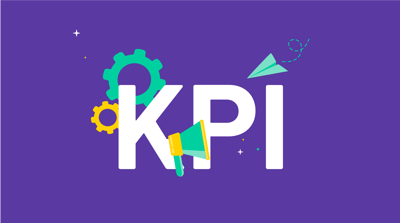
June 20, 2018
 by Grace Pinegar
by Grace Pinegar

When I was in high school, flash mobs became a big deal.
Like, a really big deal.
I remember watching flash mobs for every reason you could think of: whether someone was getting engaged, or coming home as a surprise, or a business was just trying to jump on the bandwagon while it was hot.
It never occurred to me that public, group dancing was a form of marketing.
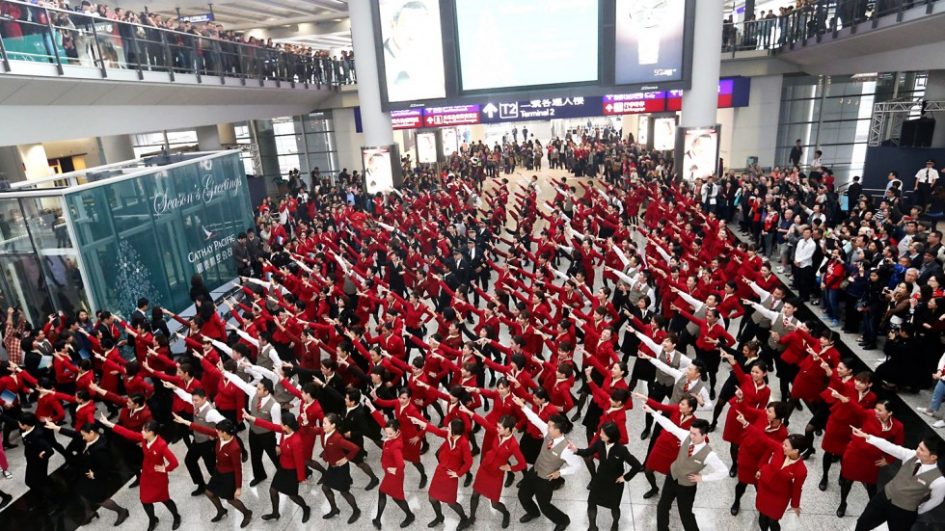
Image courtesy of Delnext.
Although the people in my personal favorite group flash mob (this proposal from 2012) weren’t marketing anything but their love, many companies have used similarly unusual grabs at attention in the hopes that they would spark a greater conversation.
Guerrilla marketing disrupts consumers in their daily routines by presenting them with unconventional methods of brand interaction. The idea is to generate conversation, a stir, or something newsworthy so brand awareness spreads either by word of mouth or through news attention.
Commonly referred to as guerrilla marketing, these displays have only grown over the years, becoming an increasingly creative attention-gathering strategy. If you’d like to try your hand at guerrilla marketing, you’ve come to the right place.
There aren’t many parallels to corporate office life and active military strategies, but you could say guerrilla marketing is one of the few, the proud. The term is derived from guerrilla warfare, the militant strategy where smaller, mobile, and sometimes civilian forces perform irregular attacks in hostile areas. Attacks include ambushes, raids, and other surprise charges.
Guerrilla marketing removes the warfare but uses the surprise or ambush elements to create a memorable marketing experience. (See: What is Marketing?) The idea is to create high impact and memorable experiences on a lower budget. This makes guerrilla marketing an ideal choice for small businesses.
|
Tip: Learn how to write a marketing plan! |
Guerrilla marketing disrupts consumers in their daily routines by presenting them with unconventional methods of brand interaction. The idea is to generate conversation, a stir, or something newsworthy so brand awareness spreads either by word of mouth or through news attention.
These methods are effective because they are a personal and unique aspect in your day’s experience. The point of this strategy is to get people talking and thinking about your brand. Guerrilla marketing can make a statement on current events, spur consumers to think critically about your product or brand, or simply serve as an entertaining moment.
“Guerrilla marketing has a major profit orientation and emphasis. Since guerrilla marketers don't have unlimited funds, they must employ smarter rather than harder ways to work. This is done through the full use of time, energy, information, knowledge and, most of all, imagination. The guerrilla marketer must use all of his or her contacts to network, find creative publicity stories, angles and outlets, and generate ideas that'll get noticed and talked about.” -Al Lautenslager, Entrepreneur
If all of this sounds ambiguous or completely made up, allow me to provide an example. In 2010, Volkswagen car company installed a playground-style slide in the staircase of a German train station. Instead of taking the stairs or escalator down to the train, commuters could take what Volkswagen labeled as, “the fast lane” by hopping on the slide and zooming down to the train level.
One thing is for certain: You know these people were talking about this big surprise slide when they got into work that morning, and perhaps even telling their co-workers, friends, and family to go check it out. The spontaneity and unusual placement of something fun – who goes to a train station for entertainment? – certainly made an impression on all involved and had them wondering about the occasion.
While this particular example features a large corporation partaking in guerrilla marketing, the strategy is recognized as ideal for small businesses. Small businesses can devote a fixed budget to a stunt and reap endless rewards, depending on the level of creativity applied. News outlets are constantly looking for the latest buzz, and if your campaign can generate interest, local-to-national channels will provide coverage and effectively advertise for you.
According to online marketing consultant Heena Shah, guerrilla marketing works on account of the following three effects:
Download a piece on guerrilla marketing hacks to learn more!
It’s easy to misuse guerrilla marketing, or to spend lots of time on a campaign that doesn’t go anywhere. That’s the risk we take in any marketing strategy, whether it be social media marketing campaigns, or television advertisements, or even print ads.
In order to be effective in your guerrilla marketing strategy, you have to front load with market research and audience understanding. Ask yourself some of the following questions:
Who are my customers, or my target audience, and what do they respond to? Not knowing your target audience will result in misguided efforts that only serve to confuse. Marketing is all about communicating with an audience you understand, and consumers know when you’ve failed to do your research.
Do I know my audience well enough to make a unique connection through guerrilla marketing? Think about this strategy in relation to that same audience. Guerrilla marketing requires a lot of interaction, and some risk on your audience’s part. If your customers – or even the people who live in the location where this campaign would take place – are not interactive, this may not be effective.
Do we have an uncommon idea that could be executed face-to-face and would drive positive attention and engagement at a large scale? A huge pitfall in many guerrilla marketing campaigns is the lack of ingenuity. If the campaign isn’t compelling and doesn’t call consumers to act or even think further on the product, it won’t go anywhere. Look at examples of successful campaigns (see below) to help determine if your idea has the potential to take off.
Can we deliver this strategy as well as it needs to be delivered? In other words, do we have the physical resources to make this happen the right way? With the Volkswagen idea, construction workers were hired to build a physical slide. Had they done a faulty job, patrons could have been hurt, resulting in the exact opposite of the desired reaction.
Do we have the right employees to effectively drive this campaign? Think about what your employees have experience with and what their skill sets are. Properly executing a guerrilla marketing campaign requires a lot of parts moving simultaneously. If your team has no experience with such campaigns, consider consultation or other external guidance.
Is it the right time for a guerrilla marketing campaign? Consider where you live and what’s going on. If you live in Chicago and it’s the dead of winter, people are barely looking up from their coats for fear of freezing their cheeks and noses. It is highly unlikely you’ll get a large group of people to stop moving and check out your message. Or, as we discuss later in this page, is an 80 degree day the right time to try and erect a giant popsicle in New York City?
Is your brand right for this type of campaign? Unfortunately in the business setting, it’s important to consider what others think of you. If your target audience would consider a guerrilla marketing campaign to be unprofessional or irritating, that could make a bad impression on your brand. You should take into account the opinions of those who matter most to your business. A younger clientele may love your campaign, but if that’s not who you’re trying to attract, maybe reconsider.
If you can give affirmative answers to the aforementioned questions, then guerrilla marketing is certainly an option for your organization. Before you decide to move forward with a campaign, however, take into consideration some of the benefits and risks.
Low budget: Guerrilla marketing is less expensive than other forms of marketing due to the potential for nation to worldwide attention. While the campaign or project itself might have a high cost to start, it’s not always comparable to other campaigns because the marketer isn’t paying for it over time. After the event or stunt has taken place, marketers depend on word of mouth to drive engagement, awareness, and sales.
Memorability: When you engage in a guerrilla marketing campaign, you’re essentially trying to get your company or brand name into as many ears as possible. This means appealing to customers, potential business partners, and even competitors.
Guerrilla marketing gives you the opportunity to really come up with something unique, as opposed to pursuing the same advertising efforts people are used to, and often tired of, seeing. Not all sales will be immediate, but it’s important to remember the long play. When you create a memorable experience for your audience, you increase the chances that they return to you further down the road. Are you more likely to remember the hair salon that handed out coupons, or the salon that set up a virtual styling booth and allowed people to see what they’d look like with a certain haircut?
Element of surprise: Some patrons walk into a store and are immediately on edge. They don’t like the face-to-face salesperson/customer interaction and are afraid they will feel pressured to buy something. Advertising can often evoke this dread in consumers. With guerrilla marketing, you’re not sticking a product or ad in your audience’s face and asking them to dole out money. You’re offering them an experience in exchange for their consideration. I’ll bet the commuters who went down the Volkswagen slide had no initial idea it was part of a campaign for a car company, but I also bet they did not soon forget the experience.
Using your team’s potential: Marketing is a creative industry full of professionals from a wide variety of backgrounds. Guerrilla marketing allows your marketers to brainstorm effective ideas without traditional limitations. Your employees are free to think big and expand beyond social media or television campaign ideas, which can result in creative fulfillment for employees.
Legal issues or misunderstandings: The lack of context is often what makes guerrilla marketing campaigns so much fun. It catches people off guard and entices them to learn more. But if your campaign is misunderstood or translated incorrectly without context, you risk doing more harm to your brand than good.
In 2007, the Adult Swim TV show “Aqua Teen Hunger Force” advertised for its upcoming movie by placing LED placards (think: a Lite-Brite) around Boston in the shape of a character named Mooninite. Boston police and firefighters mistook the placards as improvised bombs and ended up removing the devices, effectively shutting down the campaign, as well as causing city-wide scare.
One way to avoid this liability is by investing in a legal consultant, or creatively considering all the alternative ways your campaign could be misunderstood. By remaining proactive, you’re more likely to avoid an idea that would cause large scale panic or otherwise push legal boundaries.
No traditional reporting: One standard aspect of marketing campaigns is the ability to track and understand what works. Metrics such as open rates, click rates, and conversion rates all offer insight into effective or struggling strategies.
With guerrilla marketing, there is no way to measure these exact metrics. The campaign is primarily face-to-face and is not focused around a landing page or specific call to action. Before pursuing a guerrilla marketing campaign, understand that it may be largely impossible to track its exact success.
Nothing is guaranteed: While advertising on social media or in certain publications has at least some guarantee of visibility, guerrilla marketing could go completely unseen or unnoticed. Guerrilla marketing is a lot like setting up a surprise box and then hiding in the bushes to see who opens the present.
If no one engages, then you’ve gone through the trouble for nothing. Perhaps equally as bad is when people do engage but have no way of tying it back to your brand. Consumers have busy lives and likely aren’t going to spend too much time trying to figure out why there was a slide in the train station. It’s your job to make that apparent to them.
Videos—In the age of celebrities and influencers who have gained their fame through YouTube and other digital channels, every brand is trying to follow suit with their own viral video marketing content.
There is no set formula for the creation of quality, viral content; otherwise, everyone would be doing it. But there are a lot of brands that have gone before you and done a really great job of raising brand awareness in an engaging and uncommon format.
Our first example is Purple mattress company. It took a fairy tale character commonly associated with the comfortability of beds and had her demonstrate why Purple mattresses are superior to other brands. Not only was the script and character entertaining, but the brand was presenting an interesting concept along with a physical demonstration.
This particular video shows how the right kind of mattress can protect raw eggs completely from the weight of heavy falling objects. The video has accumulated more than 165 million views on YouTube, and received comments such as, “I don't know who is in charge of marketing for this company but they need to get promoted ASAP!” and “This is literally the only commercial I’ve ever gone back to watch. Well done👌🏿👌🏿👍🏿👍🏿.”
Next up, we have Dollar Shave Club with another viral video commercial. The video cost the company less than $5,000 and has since received more than 25 million views on YouTube. This video uses humor and a bit of foul language to increase interest in a monthly shaving subscription.
The spokesperson in this video, co-founder Michael Dubin, is seen walking around all parts of a warehouse, verbally explaining and physically demonstrating why the product is superior to its competitors. This company sold for billions of dollars just a few years into doing business.
“Don’t take yourself too seriously. If you can make people laugh, they’ll remember what you’re saying,” Dubin said in an interview for the Huffington Post.
Ads—How often does a modern day billboard truly make you stop and think about the product or brand, or make you want to engage further? For me, almost never. Many billboards and print advertisements have stopped engaging us in our everyday lives, largely because we’re so used to seeing them in everyday life. Guerrilla marketing advertisements take classic approaches to advertising and offer a unique twist that serves to confound or delight viewers and spur them to learn more about that company.
Take a look at this dental implant insurance company. It chose to advertise in a bowling alley and make use of the way bowling pins can resemble a set of teeth. Although patrons of a bowling alley may not have been looking for dental implant insurance during their toddler’s birthday party, you can bet this company made an impression on them. Perhaps they went on to show a photo to friends, family or office-mates. Perhaps this insurance company had a brief segment on the news following this campaign.
Props—Seeing something physically out of place can stop you in your tracks. I remember when the Cow Parade came to my hometown, my family and I took a full Saturday to walk around Houston and devote our attention to this unique art display that featured painted, glass cows dispersed around the city. Guerrilla marketing makes use of physical props by placing unexpected items in normal, everyday places.
Consider this photo of a super glue container leaning against the support of a bridge. The commentary or joke here is that super glue is strong enough to hold an entire bridge in place. While a passersby knows this is an exaggeration, it still increases brand awareness in a humorous way. Drivers aren’t expecting to see an oversized tube of super glue on their drive to work or while they’re stuck in traffic, and this bit of humor was likely appreciated by commuters.
I can talk your ear off about guerrilla marketing, but ultimately diving into examples are some of the best ways to better understand the practice. Looking at successful campaigns helps to see which wild strategies have worked for certain organizations, and perhaps inspire some ideas for your own business. These examples can also give you an idea of how brands have to uniquely understand their consumers before guerrilla marketing campaigns are anywhere near effective.
Nike—Athletic gear brand Nike is known for its unconventional displays that ultimately aim to spur people into activity. In order to raise awareness for a new reflective jacket that made runners visible at night, Nike executed an event called “Catch the Flash.”
It had 50 Nike runners take off all over Vienna in these jackets at night. Nike challenged runners to compete to see who could find and photograph the most of these flash runners. Participants in other locations were able to compete with a virtual runner through Nike’s microsite and application. The winner of this competition received a €10,000 platinum card.
This marketing campaign was effective because it incentivized users to participate and then provided multiple forums for participation. It also engaged residents of Austria by allowing them to do what many Nike fans enjoy doing: run. Talk about knowing your audience! As the video below narrates, this Catch the Flash competition didn’t just end after the 90-minute race. It continued to be published and discussed by news organizations and bloggers worldwide.
Coca-Cola—Coca-Cola has taken multiple stabs at guerrilla marketing and has managed to execute many successful campaigns. One of its most notable campaigns is the happiness machine. A mechanic “installed” a Coca-Cola machine in a busy common area of a college campus. When students and faculty approached the machine for a soda, they received a multitude of surprises.
The first customer received so many sodas that she physically could not carry them all and began passing them out to other students. Some students received full liters of Coke instead of the standard bottle. At one point, a hand reaches out and starts dispensing bouquets of flowers. One student is surprised by a sandwich so large it takes multiple hands to pull it out of the machine. Another woman receives a whole pizza.
Coca-Cola was successful in this campaign because it understood its target market. Students are often frugal, especially as the price of education increases. The surprise of going to purchase one soda and in turn receiving multiple, or in some cases an entire meal, was a visibly welcomed treat to these smiling faces. Whether the students were all friends prior to this campaign is unknown, but their connection through the excitement is evident.
Old School Andre Agassi by Nike—If you’ve followed tennis since the early ‘90s, you know the name Andre Agassi. If you have not followed tennis for decades, I’ll tell you Agassi is a current retired tennis player and former No. 1 champion. In 1995, he participated in a campaign that was referred to as Guerrilla Tennis. The video shows Agassi and Pete Sampras setting up a tennis match in the middle of a busy city street. A crowd slowly shows up to observe the match, growing over time as street traffic appears to have stopped completely. This commercial played during the 1995 US Open and showed two rival tennis players participating in a fun, surprise game in the streets of San Francisco.
WePay—WePay is an integrated payment platform that competes with the likes of Paypal and Venmo. In 2010, PayPal hosted a conference in San Francisco. WePay took this event as an opportunity to deliver some guerrilla messaging. It dropped a 600-pound block of ice at the conference for all to see. The ice had hundreds of dollars frozen within with a message in block letters reading, “PAYPAL FREEZES YOUR ACCOUNTS. UNFREEZE YOUR MONEY.”
The call-to-action or messaging here is that attendees of the PayPal conference should switch to WePay and stop having their accounts frozen. WePay employees tried to flee the scene with their pallet mover and leave PayPal with no way to remove the competitor’s message. The pallet mover was eventually chased down and WePay employees ended up pushing the block of ice around all day.
The whole charade reads much like a high school senior prank. We steal your mascot, you spray paint our football field, we put makeup on your principal’s ceramic bust. No real harm was done, but you can bet WePay became the talk of the conference – the last thing PayPal conference administrators were expecting.
Image courtesy of TechCrunch
Volkswagen—We previously mentioned Volkswagen’s Life in the Fast Lane campaign that featured business professionals using a slide to get underground to their train stop. That campaign challenged commuters to step out of their daily routine and try something fun in a usually mundane space.
Volkswagen has a separate guerrilla marketing campaign that tells a much more serious message. In 2014, it launched its “Eyes on the Road” campaign that served to remind people not to text and drive. Moviegoers sat through a preview feature a behind the wheel perspective of someone driving a car on an open road.
A mobile alert was then sent out to many people in the movie theatre, who checked their phones to view the alert. As they were staring at their phones, the driver on-screen crashed into a tree, shattering their windshield and presumably injuring themselves.
Volkswagen ended the ad by putting the text, “A reminder to keep your eyes on the road,” on the screen. While there is no concrete evidence that anyone in that movie theatre is guilty of texting and driving, the ad explained that mobile-related accidents are now the leading cause of death behind the wheel. Whereas previous marketing campaigns had the goal of delighting or entertaining, this campaign sought to teach viewers a potentially life-saving lesson.
This type of marketing is risky. Movie-goers typically don’t attend movies to feel convicted of their bad behavior. Even more so, viewers did not expect the advertisement, and were in a dark location where the driver’s crash experience felt realistic. Volkswagen chose a shocking method in order to confront a lethal trend of texting and driving.
How do you feel about this method? Do you think it was a good idea, or unfair to disrupt their outing with potentially triggering content?
One thing is for certain: Audience members are sure to remember the fright this commercial caused them any time they consider picking up their phone on the road.
Foursquare—Foursquare is an app that lets you and your friends check in to places around the world, whether it’s while you’re out dining, drinking, dancing, or more. It’s also become a resource for leisurely or professional travelers looking for things to do in a new country or city.
Back when it first started, the company lacked the same marketing budget as other big-name social media companies. At popular Austin film and conference event South by Southwest (SXSW), Foursquare founder Dennis Crowley decided to use some old-school tactics to create modern-day buzz. Legend has it he spent $5.99 on supplies to create a game of actual four square and spent the day playing against other people at the event.
This technique was the opposite of costly, and had festival visitors both participating and telling others about their experience. Foursquare didn’t need to spend the copious amounts of money other brands spent on their booths or giveaways, because its idea was priceless. Standing outside, presenting the chance to join in on a nostalgic name, and having face-to-face interactions with potential users likely helped this organization receive more engagement than many others did.
Foursquare has since grown and changed, and Dennis Crowley no longer works with the organization. But that original act of ingenuity has certainly remained a lasting value within the brand.
Image courtesy of HubSpot
Penguin Random House Canada—Well-known publishing company Penguin Random House proved to fans and Toronto residents that, sometimes, our beloved book characters can come to life. When David Lagercrantz’ book The Girl in the Spider’s Web was set to be released (you may know this book as part of the Millennium series, the first of which was The Girl With the Dragon Tattoo), Penguin Random House thought it’d take a unique approach to promotion.
The publisher hired 20 actresses to dress up as the book’s main character, Lisbeth Salander. Looks included her iconic facial piercings, dark hair, tattoos, and even a few mopeds, for character accuracy, of course. The actresses spread out throughout Toronto and handed out small excerpts of the new book to passerby in the hopes of gaining their interest.
In addition to the women physically handing out books, the @PenguinCanada Twitter account claimed to have been “hacked” by Salander herself. The account was updated throughout the day with the various locations people in Toronto could find Salander. This planned, faux hack also spread to other Twitter accounts, increasing the audience reach way beyond their physical location.
Penguin Random House was able to use its creativity to not only cause a stir in Toronto, but also to attract attention through its social media profiles. Imagine how much fun this stunt was for fans of the book. To see your favorite character not only tweeting on multiple “hacked” accounts, but also “alive” and walking around. This idea was so uniquely different from a book tour or book signing, and no doubt drummed up excitement for the next installment in the book series.
This isn’t the first time Penguin Random House was involved in a guerrilla marketing campaign—voluntarily, or involuntarily.
“With the aim of turning PRH's headquarters into an advertisement for his work Be More Pirate (Penguin), out on Thursday (3rd May), Sam Conniff Allende affixed an 8-metre-long fluorescent billboard-style poster across the front of PRH's building on Vauxhall Bridge Road, London - apparently without his publishers' knowledge, approval or permission,” wrote Katherine Crowdey for The Book Seller.
Allende dressed up as an official contractor in order to evade questioning and hung up a promotional poster with the money he had been advance-paid for a future event. While the stunt was unexpected, it did not go unappreciated.
"When we commissioned Sam we knew it was a chance to see how he'd do things differently,” said Penguin Random House CEO, Tom Weldon. “Whilst I didn't realise I was indirectly paying to flypost my own offices, and I won't be doing that again, I do applaud his spirit of rewriting some rules and appreciate an author who's willing to take risks to prove books build movements."
Richard Branson even tweeted in celebration of the author’s ingenuity, encouraging others to continue asking for forgiveness and not for permission. While these tactics could have been received differently under a different manager, Allende’s strategy seems to have made a positive impact in this scenario.
Distance Series—Distance Series is a TV show that takes a comical look at modern love. The web series tell the tale of a long-distance relationship with each episode being told by both of the main characters’ perspectives. Long-distance relationships are full of complications and miscommunications that lack the context proximity can often provide. The idea of this show is that viewers get to choose which side they want to watch first and experience episodes from the varied perspectives.
If this web series is anything like the series’ my friends create, their budget is likely much lower than that of a syndicated TV show. This means – you guessed it – advertisement strategies have to be low-budget and highly creative.
This tweet from Emily Best shows the web series has chosen to advertise the uniquely complicated communications of long-distance partners.
The poster includes a call to action at the end that seeks to compel people to check out the series online, complete with rip-off strips that people can keep for later.
If you had passed this poster, would it have caught your eye? Would you have been interested to learn more about the show, or would you have kept walking?
Vegetarian Restaurant—When you work at a vegan or vegetarian restaurant, you most likely want to show others the beauty and flavor you see in food that comes from the earth. That’s exactly what this currently unknown vegetarian restaurant did with a simple guerrilla marketing tactic.
It aligned an oversized fork with the trunk of a tree, with the prongs of the fork going “into” the tree branches and leaves. From far away, it looks as if a fork is being stuck into broccoli.
At first glance, you’re caught off guard – why is there a fork in the tree I pass every day to go to work!? But when you get closer, you can see there’s writing on the fork that likely details the name of the restaurant, or encourages people to eat more vegetables.
Although broccoli has mixed reviews among taste buds, trees are usually perceived as a natural and respected aspect of nature. This simple guerrilla marketing campaign seems to be pointing out how natural it is to eat vegetables, and how broccoli should be as routine as walking past a tree in the park.
At least, that’s my artistic interpretation! Do you have any thoughts about the possible deeper meaning? Is it just a funny visual and I’m reaching for a meaning? A successful guerrilla marketing campaign makes us think about the stunt and what its creator wanted us to think.
MilkyWay—Ah, MilkyWay. That sweet, delectable candy you don’t realize you’re eating until you’re four snack-size bars in. Does it even need advertising? Apparently so!
Consider this progression of pictures which plays with the idea of how stretchy the caramel inside the chocolate can be.
The candy bar begins on the conveyor belt looking like a complete bar of chocolate. As the conveyor belt moves, it “drags” caramel along with it, mimicking the pull of the candy within.
If you’ve had a Milky Way, you probably know the caramel does not stretch as long as a grocery store conveyor belt. The ad is hyperbolic, to say the least. But the visual is entertaining, and consider where it’s reaching people: at the end of their grocery trips.
How many times have you been in line at a grocery store, or gas station, and thrown a candy bar on the counter simply because it’s right there beside checkout? Now consider how much more that temptation would affect you as you’re standing in line, watching the caramel “ooze” out of the chocolate coating. If this ad found me at the end of an after-work shopping trip, I would definitely be done for.
Tic Tac—Have you ever had a one-on-one meeting, or been on a dinner date, or sat on the airplane next to someone whose breath could make flowers curl up and die? That’s an exaggeration, but we’ve all been there. And that is exactly the kind of feeling Tic Tac was trying to conjure up in its flash mob advertisement that took place in Rouen, France.
The spectacle began with a secret actor asking someone for directions to the train. While the stranger is answering the question, the actor pretends to faint, which has a domino effect as all of the people around him begin to fall to the ground.
As the strangers stand there dumbfounded, wondering if all of these people have perished in front of them (one man literally takes off running), a video begins to play. It shows yet more people fainting all over the city; on trains and busses, in radio stations, and outside of restaurants. At the end of the video is one simple plea: Take a Tic Tac.
One of the actors on the ground reaches up and hands the stranger a Tic Tac, as they gleefully begin to piece together what this whole thing has been about: Their supposedly rank breath has made half the city lose consciousness.
This guerrilla marketing strategy is probably my favorite one so far, as it makes use of a couple of my favorite things: overly-dramatic fainting in a large group setting, an innocent participant who has no idea what’s going on, and prolonged continuation of the bit. Tic Tac thought it would be funnier to see this joke continue throughout the town, and I’d have to agree with them.
Additionally, this strategy presented an immediate solution to the problem at hand: take a Tic Tac, which resulted in cheering, fireworks, and streamers.
Warning: if you are reading this article in your office space, proceed in playing the following video with caution. I laughed so hard I cried, and then laughed some more.
Gorilla Beach—Maybe you’ve heard of Muscle Beach, but Gorilla Beach? That’s probably a new one.
We are living through a time where movie studios are obsessed with the idea of giant monsters: Jurassic Park, Jurassic World, and almost any movie with Dwayne “The Rock” Johnson. In order to make your giant monster movie truly stand out, you have to do something creative and unprecedented.
Enter: the King Kong “appearance” on a beach in California that featured hulking footprints in the sand. Not much further down the shoreline was a smashed beach patrollerJeep that appears to have been “stepped on” by the animal.
This strategy was just ridiculous enough to not cause a legitimate scare. Smaller footsteps could possibly have been understood as a zoo animal running loose, which would have caused more harm than good. By making the footprints obviously impossible, the marketing team protected this campaign from the potential to backfire.
Anthony Davis Unibrow—NBA player Anthony Davis is known, among other reasons, for his beloved unibrow. Kind of like Enrique Iglesias was known for his mole, prior to having it removed.
Davis tweeted on March 31, 2018, a video of himself supposedly shaving the middle of his unibrow. (He also had a Red Bull towel draped over his shoulders—remember our lesson in product placement?)
The next day, he tweeted another picture of himself with the unibrow fully in place. His caption read, “Come on y'all!! Y'all knew I wasn't cutting it lol. #AprilFools We got ya!!” and then tagged Red Bull in the end.
Turns out, the entire thing was an April Fool’s prank. Although fans voted a majority “yes” that Davis should shave his brows in a Twitter poll, he never had any intention of changing his look.
This tactic is unique in that it truly has nothing to do with Red Bull, save the product placement and celebrity endorsement. Red Bull is a sponsor of Davis as you can see on its official website, and probably approached him with this marketing idea and paid him to take part in the gag.
It fits into the guerrilla marketing category in that it surprised viewers. Fans of Davis were not expecting him to shave off his unibrow, a feature for which he has officially trademarked slogans. It also caused some conversation. The Twitter poll itself saw more than 600,000 participants. Can you imagine that many people caring about your facial hair habits?
Dollar Shave Club—We mentioned Dollar Shave Club earlier, but its ingenious advertising strategy is worth a reminder. Remember that it paid less than $5,000 for its first video advertisement which gained more than 25 million views.
In giving advice for successful marketers, remember Dollar Shave Club co-founder Michael Dubin’s words: “Don’t take yourself too seriously. If you can make people laugh, they’ll remember what you’re saying.”
Guerrilla marketing isn’t a normal strategy, and it involves bigger-than-normal ideas. Dubin encourages other marketers to think outside of whatever box they feel this industry has created for them.
Ikea—Okay, this next guerrilla marketing campaign I am actually hoping will come to Chicago. Swedish furniture and home-living store Ikea took over Manhattan with its whimsical and efficient designs. Examples of its influence include distributing water bowls around the city for dogs, placing stools in front of pay phones, and building full furniture vignettes at bus stops.
The slogan for this campaign was, “Good design can make the everyday a little better,” and Ikea was right. Each of its contributions to the city made something just that much more convenient, or comfortable, or aesthetically appealing.
While it’s not exactly logical for me to bring my couch to the bus stop everyday, the message Ikea was sending certainly got across. It has plenty of designs and products that can transfer that kind of efficiency and whimsy into your everyday life.
Deadpool—Deadpool is a marvel character with incredible healing powers whose movie was released in 2016. In an effort to increase attention for the sequel, Deadpool 2, the character began making appearances on the cover of Blu-ray cases for other films such as X-Men, Assassin’s Creed, and Office Space.
The films themselves have nothing to do with Deadpool 2, but those who purchased the Blu-Rays were promised a discount on movie tickets to go enjoy the film’s release.
This guerrilla marketing tactic is unique in that it does what every movie-goer or TV watcher loves: a crossover between worlds. Although we don’t actually see these characters interact in the film, seeing them interact on the cover of the box is exciting in and of itself.
One thing that surprises me about this campaign is its use of Blu-ray as a platform for attention. With the increase in popularity of streaming devices and services, I know I personally have not stepped foot into the DVD or Blu-ray aisle of a store in a long time. Additionally, with the rising popularity of MoviePass, I have to wonder how many people are enticed by a $5.00 discount on a single movie ticket.
This campaign raises the question of whether platforms determine an advertisement’s success. The tweet regarding this campaign, posted by @FilmFeed, received 14,000 likes and 8,483 retweets, meaning it was able to reach more than just the single person regarding the cases in the photograph.
We’ve already discussed that the success of guerrilla marketing campaigns is difficult to track, as there are no traditional landing pages or click rates available. But do you think a campaign such as this was effective? Again, I ask for your opinion. Would you have shared this idea, purchased the film, or used the discounted movie ticket?
Here are some more examples of guerrilla marketing campaigns put on my companies worldwide. Can you tell what their message or gimmick was just by looking at the photos?
Beau Rivage Resort and Casino uses the baggage claim belt at an airport to advertise a lazy river or other calming pool imagery.
Woman on Weight Watchers ad appears to lose weight as observers tear off details.
Ketchup packets raise awareness for countries across the world still plagued by frequent landmine explosions.
Discovery Channel raises awareness for its upcoming 10th Anniversary Shark Week, an annual celebration of these sea predators that has become a sort of ritual to shark enthusiasts worldwide.
Washing your hands regularly is a great way to avoid getting the flu. Kleenex took advantage of this truth by using soap dispensers to visually portray a man sick with the flu, reminding them both to practice good health and hygiene, while also advertising its tissues. It’s a good message that although Kleenex profits during times of sickness, it still doesn’t want people to become ill.
Coca-Cola advertises bottle’s new grip by physically taking hold of people’s clothing at a bus stop.
Copenhagen Zoo advertises its wild animals with this realistic image of a snake wrapping itself around a bus.
Covergirl makes use of train turnstiles by comparing them to eyelashes.
Nivea implies its ability to smooth out cellulite in skin with the use of a half-smooth, half-tufted leather couch.
Folgers paints over a manhole to make it look like a cup of morning coffee is steaming on the ground.
Do you have any favorites that we might have missed? Or has your organization put out a campaign worth sharing? We’d love to see what kinds of guerrilla marketing campaigns are inspiring your company or growing your reach.
A lot of guerrilla marketing is about taking risks and not being afraid to try something. As one of my idols, Ms. Frizzle, would say, “Take chances, make mistakes, and get messy!”
But no good marketing campaign is without strategy and foresight. As we spoke of earlier, one seemingly innocent attempt at advertising for an animated film was wrongfully perceived as a bomb threat, and is to this day referred to as a bomb scare.
I am of the opinion that we can learn as much from unsuccessful campaigns as we do from those that excelled. By examining where and how certain guerrilla marketing efforts went wrong, we’re able to more accurately consider how our own ideas could be misconstrued.
Let’s consider the experience of Emma McGowan, a blogger who has worked for Startups.co, among other publications. McGowan came home one day to a package from an address she didn’t recognize. When she looked up the address and the sender’s name, she realized it was related to a pitch she had recently received via email.
McGowan was put off by the fact that she had neither responded to the pitch nor disclosed her home address. While the startup founder who sent the package likely thought they were being personable and thoughtful, McGowan perceived the situation completely differently: as a pushy attempt to gain her attention, and an inappropriate use of personal information. As another female professional, I can agree with her that receiving unsolicited mail from an unsolicited male at your home address is a fairly invasive tactic.
McGowan’s experience reiterates something we’ve briefly touched on: don’t just consider the way you view this campaign, but consider all the ways this campaign could be viewed. This is challenging because we only see the world from our singular perspective. If you’re having doubts, ask focus groups or colleagues what they would think about the campaign in mind. Had this particular startup founder spoken to a few female cohorts, they may have predicted this reaction and avoided the burned bridge.
Event management application Pozzle creators Rich Tu and Charles Jamerlan set out late one evening to distribute 1,000 of their brand’s stickers across NYC. According to the founders, they were about 500 stickers along when an unmarked cop came along and arrested them. The two spent the evening in jail and were eventually released with a sentence of 21 hours of community service.
Tu said he enjoyed completing the community service, and the whole story has at least been an anecdote to bring publicity to Pozzle. According to Business News Daily, “Tu doesn't regret his actions and said the company has really taken off since that November night. Pozzle has tripled its users and recently signed partnership deals with a large event management company.”
While Tu’s experience turned out for the better, there remains a lesson to be learned here. Before embarking on any guerrilla marketing ideas, ensure what you’re trying to accomplish is legal. The outcomes aren’t always as light or devoid of lasting consequence as this narrative was. Partaking in illegal methods to advertise your business does not have a guaranteed positive outcome, so do a good deal of research in advance to be certain you have nothing to worry about.
Snapple embarked on a mission to create the world’s largest popsicle, standing at 25 feet tall and weighing in at 17.5 tons.
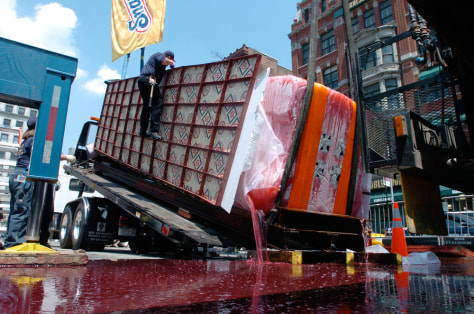
The team ambitiously aimed to set up the popsicle on a June day in the middle of Manhattan, causing the popsicle to begin melting before it could even get lifted upright.
The popsicle is said to have flooded the streets of Union Square while those walking in the city scrambled to escape the gooey path. Firefighters were called in to hose down the streets and ended up closing off a few streets to do so.
Can you imagine how big of a disaster this must have been for Snapple? It was trying to beat the record for largest popsicle, which had been set at 21 feet in Holland in 1997. The company had been assured the scheme would work, only to have the prop begin to self-destruct before it could ever get it upright.
This campaign was more so an issue of logistics. The environment simply did not agree with the product. Organizers were expecting the popsicle to be able to withstand the heat, and were not able to pinpoint where they went wrong. What does this attempt teach us? Expect the unexpected. Even if all of your research points one way, prepare for the possibility of adverse circumstances or reactions.
Sensitivity to your audience is also important when preparing a guerrilla marketing campaign. The 2008 film Forgetting Sarah Marshall tells the story of a man recovering from a difficult breakup. Or was he trying to get her back? I don’t know, I don’t like watching films about bitter men stalking girls who don’t want to be with them.
In order to advertise for the film, marketers commissioned street art that said things such as, “You suck, Sarah Marshall!” While the phrases were aimed at the film’s main character, real-life women with the name Sarah Marshall were hurt and offended, and responded with their own signs or frustrated messaging.

In this scenario, producers failed to consider the impact their campaign would have outside of the world of this film. While it was aimed at a fictional persona, imagine a Sarah Marshall seeing that sign and not understanding what it was for. Was their boss mad at them? Is their partner angry? Did their sibling finally figure out who really crashed the car back in ‘92?
Seeing your name plastered on a wall with no context is concerning, at best. Producers should have considered the far-reaching effects of their campaign.
In conclusion, let’s round up the lessons we learned from these unfortunate guerrilla marketing campaigns:
—Don’t just consider your own intent, but take into consideration the way your campaign could be received. Gain perspective by consulting a diverse range of people.
—Understand the legality of your ideas before setting out on your quest. Overlooking the law and assuming your practices are above it can result in some surprise scenarios.
—Hope for the best, prepare for the worst. Even if all of your research points to a perfect execution and a great reception, have backup plans for your backup plans. Proactively considering what could go wrong means avoiding various stages of disaster.
—Consider the real-world consequences or effects your campaign could have. If the campaign has the potential to hurt people, perhaps go a different route.
Guerrilla marketing can seem like a big undertaking. There are a lot of moving parts to consider, as well as the previously discussed risks and benefits to weigh and weigh again.
If you’ve been avoiding a guerrilla marketing campaign because you don’t feel supported or don’t know where to begin, begin here. The following is a list of resources to help you get going on a campaign that is sure to stir up conversation.
Like regular marketing agencies, guerrilla marketing communication agencies exist to help you with this particular genre of outreach.
These specialty agencies can help you and your organization in a number of ways. If you have an idea but are lost in the execution, they can come in hot with the details. If you’ve yet to get to the ideation stage because you’re so hung up on the logistics, they can also help relieve you of that burden.
Guerrilla marketing agencies usually don’t adhere to this one genre, but rather focus on a myriad of the terms we discussed earlier. Have you been working on your marketing vocabulary? Experiential and ambient marketing services are also offered by many of these agencies, as they each feature face-to-face interactions between the consumer and the campaign.
But how do you go about finding an agency capable of steering you in an effective guerrilla marketing campaign? Consider the following text from this post by Creative Guerrilla Marketing, which outlines five great communication agencies, which have locations in multiple cities, as:
-HotCow: Since 2006 we’ve made it our mission to deliver 50% more effectiveness with each campaign than you’d experience with anyone else. We’re a multi award-winning experiential marketing agency across a number of categories including; Most effective experiential campaign, best use of budget and Best experiential at point of sale.
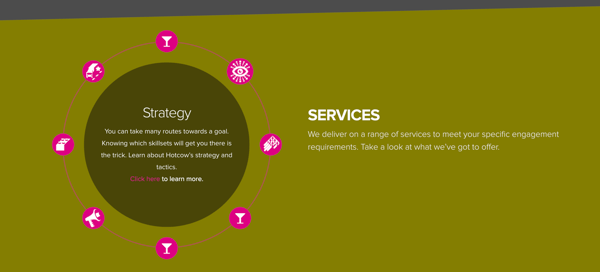
With over 15 years activation experience, we are proud of our reputation as the ‘go-to’ people for Experiential excellence. Our passion is always on show, we are fun to work with and reliability is the hallmark of our business.
-Alt Terrain: Achieve your company growth goals with experiential marketing, brand activation, and street-level outdoor advertising solutions. One-day activations, ongoing initiatives, and experiential marketing consultations to find, attract and convert people into customers.
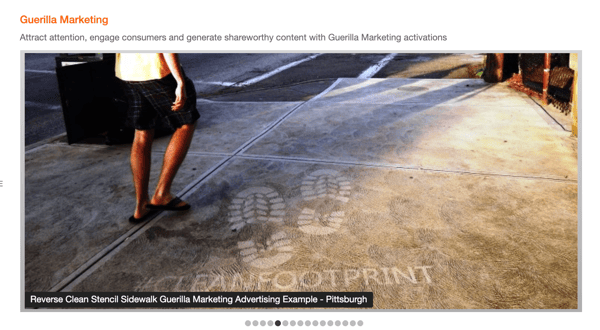
Providing brands with original, relevant, and effective experiential consumer engagement to achieve objectives is what we love to do. Brands and agencies alike work with ALT TERRAIN to produce marketing activations that people embrace and share.
-Attack Marketing: We believe that a creative concept is most memorable and influential when it stays as true as possible to its originally envisioned form. Attack!’s account team is knowledgeable on all levels of activating an experiential event or tour.

We know the recipe for the perfect event – expert production, fulfillment, staffing, deployment, and overall execution is essential in bringing an experiential idea to life. From event management, run-of-show, scheduling and routing, to onsite customer service training, our teams are experienced in all areas of event activation.
-Torke: At TORKE CC we provide Creative Consultancy services to brands and companies in search for new methods and insights for their marketing and communication challenges, business and product development.

-The Michael Alan Group: Whether it is a headline-grabbing publicity stunt in Times Square or a strategic brand partnership, at the Michael Alan Group we pride ourselves on finding new & exciting formats for connecting brands with their target audience. Product launches, digital integrations, and national tours are just a few of the ways we inspire audiences to act. And we do it all in house.

(For more information about each marketing agency individually, click on the original post or follow the company links directly. If you’re interested in an agency but see they don’t service your city, try contacting them to see if they offer remote campaigns. It’s always worth a try!)
The concept of guerrilla marketing actually began with a book of the same title by Jay Conrad Levinson. “Guerrilla Marketing: Easy and Inexpensive Strategies for Making Big Profits From Your Small Business” was published in 1983 and boasts almost 200 consumer reviews on Amazon.
The book is a recommended read for any organization looking to make guerrilla marketing a routine strategy. The book’s description reads:
“When Guerrilla Marketing was first published in 1983, Jay Levinson revolutionized marketing strategies for the small-business owner with his take-no-prisoners approach to finding clients. Based on hundreds of solid ideas that really work, Levinson’s philosophy has given birth to a new way of learning about market share and how to gain it. In this completely updated and expanded fourth edition, Levinson offers a new arsenal of weaponry for small-business success including
* strategies for marketing on the Internet (explaining when and precisely how to use it)
* tips for using new technology, such as podcasting and automated marketing
* programs for targeting prospects and cultivating repeat and referral business
* management lessons in the age of telecommuting and freelance employees
Guerrilla Marketing is the entrepreneur’s marketing bible -- and the book every small-business owner should have on his or her shelf.”
One reviewer had a lot to say about the instructional novel and wrote:
“This book is outstanding. After each chapter it fills you with such inspiration for your business you will have to put it down and start acting on the secrets you KNOW your competition is overlooking.
As a small tackle shop that carries fishing flies and supplies, not many - if ANY - of my competitors are doing any of the secrets locked within these pages...This book will do more for ANY business, or business who wants its employees to further the image, word, branding, marketing and every aspect of the business. Before I bought this book I always thought to grow, you needed to spend big bucks on marketing and advertising.
Written to be inspiring, it WILL call you to action with real world applications they won't teach you in business school, because some of the most effective things have little or no cost! We were wasting so much money before, just missing the point or not understanding how people work. Practicing what he preaches, this author has made some struggling companies turn into daily household words... and even cultural icons - Like The Marlboro man, Proctor and Gamble, and a multitude of others. Learn from those who can show you some of their successes.” —Lloyd Metcalf on April 14, 2008 (Review has been parsed for relevance to article—click link for full dialogue.)
Another book written by Levinson is Guerrilla Marketing in 30 Days. Amazon describes this book as, “Updated with fresh examples, the latest techniques and trends, new success stories, and fresh, practical marketing habits for today’s aspiring guerrillas, this new edition provides marketers with the latest guerrilla marketing tools and tactics. In just 30 chapters and 30 days, famous marketers Jay Conrad Levinson and Al Lautenslager show eager entrepreneurs how to zero in on their marketing goals and maximize their profits.
New marketers learn from updated real-life examples and success stories and proven fundamental concepts, and use daily exercises to take their marketing to the next level — ultimately increasing profits, cutting costs, and gaining new customers. Topics detailed in this new edition include proximity marketing, thought leadership, integration of online and offline marketing, speaking and events, direct email, personalization, and implementation. With every step, Levinson and Lautenslager provide thorough action plans to help aspiring guerrillas stay on track, leaving no excuse for anything but success.”
If you’re looking for a more niche text, you could check out Guerrilla Publishing: Dangerously Effective Writing and Book Marketing Strategies. This book was written by Derek Murphy and has book-specific guerrilla marketing advice. Do you think Sam Conniff Allende, author of Be More Pirate, could have benefited from reading this text?
As of yet, there is no solution, algorithm, or bot that can auto-generate a guerrilla marketing campaign. And would you want one? These campaigns are so effective and fun because individuals are using their unique creativity to communicate with audiences.
(Seriously, I know we’ve already moved past it, but I still cannot laughing about the Tic Tac commercial. I showed it to my co-workers and it holds up after a second and third watch.)
While there is no guerrilla marketing software category that I can point you to, there are other types of software that could assist in your efforts to create an amazing campaign. Consider the following tools and solutions.
Influencer marketing software — Influencer marketing software helps organizations identify, recruit, and communicate with social influencers. Influencer marketing systems are used to locate and manage new and existing brand advocates within a unified platform. These products allow organizations to recruit new influencers with built-in searchable marketplaces. Organizations can filter through influencers by establishing a detailed search criteria.
Influencer marketing products also provide features for curating influencer-generated content, creating branded marketing material, and analyzing the performance of social influencer campaigns. Organizations use influencer marketing software to create and manage marketing campaigns that depend on the use of social influencers as representatives of a brand or product.
Some influencer marketing products can further facilitate and manage athlete and celebrity sponsorships. Influencers are often a cheaper way to get massive publicity.
Idea management software or project management software — Guerrilla marketing is all about ideas, is it not? Why not invest in a solution that can help you manage those ideas bursting forth? Idea management, or ideation management, software structures the process of gathering insight on products, then organizing and managing those ideas for the purpose of improvement or development. This feedback comes from employees, customers, and partners, etc., for the explicit purpose of adding the feedback into future products or product releases.
Idea management software enables companies to solicit feedback via email, web-based applications, or forms that employ online collaboration channels to discuss the feedback to capture and store ideas. Idea management software is a step up from the traditional office suggestion box that allows for strategy that enables companies of all sizes to continuously innovate and grow.
Idea management software facilitates the full transparency of a company, as anyone who has access to the database can track ideas from inception to implementation. Ideas are collected from all areas of the organization, beyond specialized departments like R&D, product management, and marketing.
Campaigns are projects in their own right. A project or idea management solution would help your organization keep track of its many moving parts.
Survey software — We spoke previously about the need to gather opinions from a variety of sources in order to consider different ways a guerrilla marketing campaign could backfire or otherwise achieve a negative reaction. Survey software is just the solution to assist you in gathering those opinions and can even be done so anonymously.
Survey software allows user to easily create online surveys, quizzes, polls, and other web forms that are then distributed to product users to conduct market research or solicit feedback and opinions. Survey software products give companies or individuals insight into what participants think of events, projects, customer service, or another aspect of their business.
Survey software are third-party add-ons that work to amplify the efforts of the marketing and customer success departments to understand how their customers work and what they want. Surveys can either be pop-ups on the site or be sent out in email blasts.
Video editing software — If you’re doing a guerrilla marketing campaign, it’s likely you’ll want to record reactions so you can increase your reach by sharing content to social media profiles. Video editing tools can help take you from an amateur filmmaker to semi-pro (this is an exaggeration, but even I only took a couple of film editing courses in college and was able to create course-passing content).
You also don’t have to have advanced equipment. Smartphones in the modern era are equipped with high-quality cameras, so much so that smartphones have been used to make award-winning films. There are even many free video editing software.
On-demand staffing providers — If you’re looking to do something similar to the Tic Tac video (and please do, I need a good laugh), you’ll need employees that are willing to fake-faint on command. If you’re looking to create a slide in a train station, you will again need labor to help out.
If you want people to run all over a city for a night, you’ll need labor to help out (although in Nike’s particular situation, I believe they used their own employees who they knew were capable of running for 90 minutes). On-demand staffing providers can help you find the help you need to make campaigns run smoothly. These providers can assign members for anything, from a short-term errand, to all-day events.
I have had so much fun going through these marketing strategies with you. Guerrilla marketing is truly the most creative business practice I’ve yet to discover, and every example led me to either laugh out loud or think critically about a vexing world issue.
I hope you feel empowered and encouraged to go for your guerrilla marketing dreams. There is no limit to the good ideas that are possible; don’t trick yourself into thinking the time for your brilliant campaign has come and gone.
Learn about other types of marketing:
Grace Pinegar is a lifelong storyteller with an extensive background in various forms such as acting, journalism, improv, research, and content marketing. She was raised in Texas, educated in Missouri, worked in Chicago, and is now a proud New Yorker. (she/her/hers)
Remember this one rule when creating marketing reports: know your audience.
 by Mac Mischke
by Mac Mischke
How many times have you opened an email from a brand or a company only to see your name...
 by Lauren Pope
by Lauren Pope
The first page of the marketing bible reads: “measure your KPIs”.
 by Daniella Alscher
by Daniella Alscher
Remember this one rule when creating marketing reports: know your audience.
 by Mac Mischke
by Mac Mischke
How many times have you opened an email from a brand or a company only to see your name...
 by Lauren Pope
by Lauren Pope
Never miss a post.
Subscribe to keep your fingers on the tech pulse.


